Getting your son ready for school doesn’t have to be a daily battle, especially when it comes to his hair.
The right haircut can transform chaotic mornings into smooth, stress-free routines while keeping your child looking sharp and confident throughout the school day.
Whether your boy prefers classic styles or modern trends, finding a low-maintenance yet stylish haircut is essential for busy families juggling homework, activities, and early wake-up calls.
This comprehensive guide to “Effortless Mornings: Top 32 School-Ready Boys’ Haircuts You’ll Love” explores practical, age-appropriate hairstyles that require minimal styling time, suit various hair types and face shapes, and comply with most school dress codes.
From timeless crew cuts to trendy textured crops, you’ll discover haircuts that your son will love wearing and you’ll appreciate for their simplicity and durability between salon visits.
Contents
- 1 1. Classic Crew Cut
- 2 2. Textured Crop
- 3 3. Buzz Cut
- 4 4. Side Part
- 5 5. Ivy League Cut
- 6 6. High and Tight
- 7 7. Comb Over
- 8 8. French Crop
- 9 9. Faux Hawk
- 10 10. Caesar Cut
- 11 11. Undercut
- 12 12. Taper Fade
- 13 13. Spiky Top
- 14 14. Bowl Cut (Modern Version)
- 15 15. Messy Quiff
- 16 16. Short Afro
- 17 17. Temple Fade
- 18 18. Mohawk Fade
- 19 19. Slicked Back
- 20 20. Curly Top with Fade
- 21 21. Pompadour (Youth Version)
- 22 22. Burst Fade
- 23 23. Brushed Forward
- 24 24. Angular Fringe
- 25 25. Drop Fade
- 26 26. Textured Fringe
- 27 27. Short Dreadlocks
- 28 28. Scissor Cut
- 29 29. Long Top with Short Sides
- 30 30. Skin Fade
- 31 31. Regulation Cut
- 32 32. Mushroom Cut
- 33 Tips for Choosing the Right School Haircut
- 34 Hair Care Products for School-Age Boys
- 35 Communication with Your Barber or Stylist
- 36 Managing Different Hair Textures
- 37 School Dress Code Considerations
- 38 Budget-Friendly Haircut Options
- 39 Seasonal Haircut Adjustments
- 40 Dealing with Cowlicks and Growth Patterns
- 41 Building Your Son’s Hair Care Routine
- 42 Common Haircut Mistakes to Avoid
- 43 Supporting Your Child’s Confidence
- 44 Conclusion
1. Classic Crew Cut
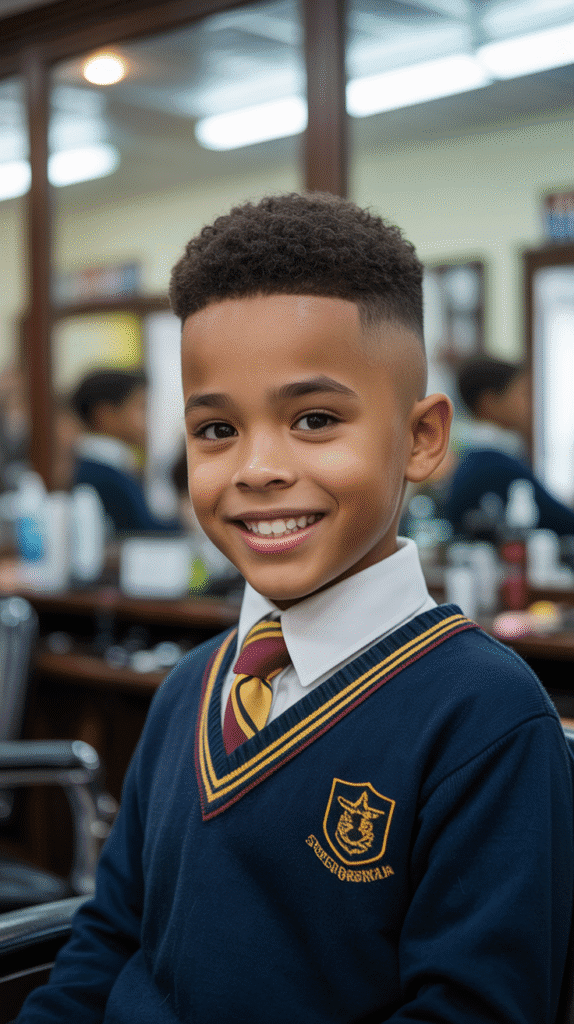
The crew cut remains one of the most dependable choices for school-aged boys who need a no-fuss hairstyle.
This military-inspired cut features short sides with slightly longer hair on top, creating a clean and professional appearance that works for boys of all ages.
- The crew cut requires virtually no morning styling, making it perfect for boys who hit the snooze button multiple times.
- This haircut grows out evenly, meaning it looks presentable for 4-6 weeks between trims.
- It works exceptionally well for boys involved in sports, as it keeps hair away from the face during physical activities.
- The style suits all face shapes and can be customized with slightly longer or shorter lengths based on personal preference.
- Most schools accept this traditional cut without any concerns about dress code violations.
2. Textured Crop

The textured crop has become increasingly popular among school-age boys for its modern edge and easy maintenance.
This cut features short back and sides with a textured, slightly messy top that creates natural movement.
- The textured finish means imperfections actually add to the style rather than detract from it.
- Parents can achieve the look with a small amount of lightweight styling product or simply by tousling damp hair.
- This cut works particularly well for boys with thick or coarse hair that has natural body.
- The style maintains its shape well throughout the school day, even after gym class or recess activities.
- It offers a contemporary look that helps older elementary and middle school boys feel confident among their peers.
3. Buzz Cut
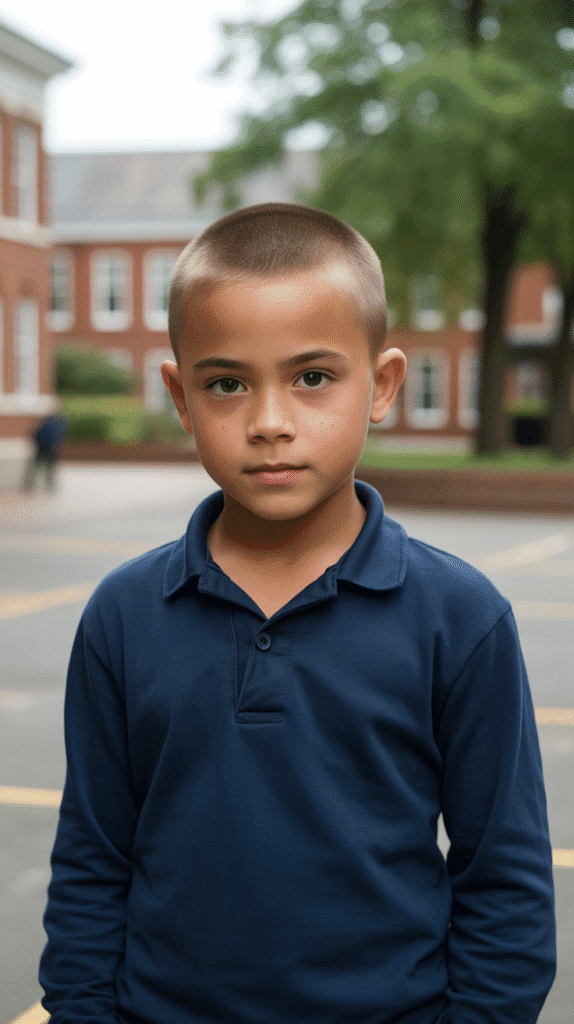
The ultimate low-maintenance option, the buzz cut eliminates morning hair routines entirely.
This ultra-short style uses clippers to create an even length all over the head, typically ranging from 1/8 inch to 1/2 inch.
- The buzz cut is ideal for active boys who swim, play contact sports, or simply prefer not to think about their hair.
- This style requires the most frequent trims (every 2-3 weeks) to maintain its neat appearance.
- It’s an excellent choice for hot climates or summer months when school is in session.
- Boys with cowlicks or difficult hair patterns benefit greatly from this style since it eliminates all styling challenges.
- The minimal hair length means shampoo and drying time are reduced to mere seconds.
4. Side Part
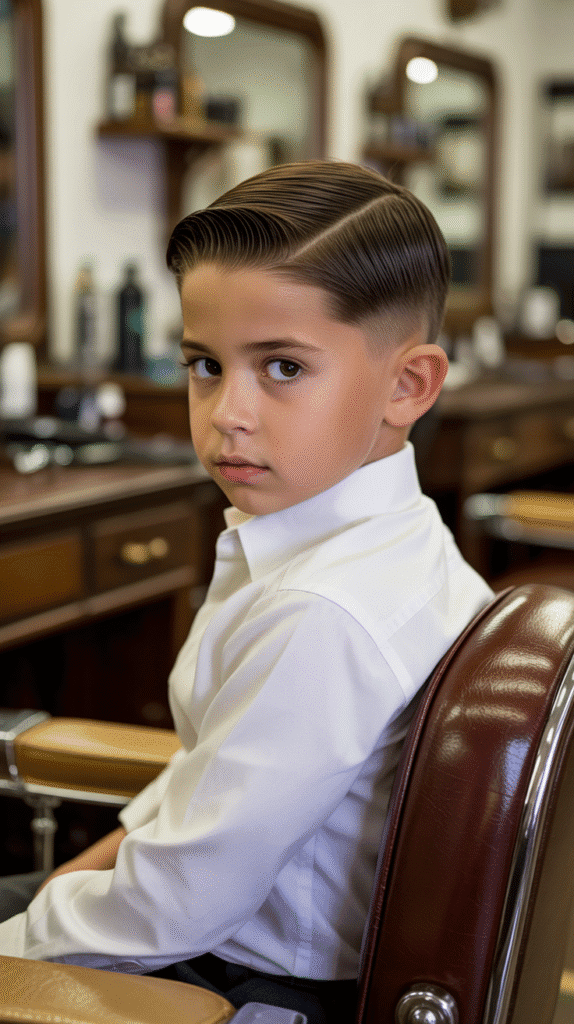
The classic side part brings timeless sophistication to boys’ hairstyles while remaining school-appropriate and manageable.
This style features a defined part on one side with hair combed neatly across the top.
- The side part works beautifully for formal school events, photos, and special occasions while still being practical for daily wear.
- Parents can create the look in under a minute with a comb and a small amount of pomade or gel.
- This cut suits boys with straight to slightly wavy hair and provides a polished appearance that teachers and administrators appreciate.
- The style can be adjusted to be more or less formal depending on how much product is used and how precisely the part is defined.
- It’s an excellent choice for boys attending schools with stricter dress codes or traditional environments.
5. Ivy League Cut

The Ivy League cut, also known as the Harvard clip or Princeton cut, offers slightly more length than a crew cut while maintaining the same professional aesthetic.
This style keeps the sides short while leaving enough length on top to create a small side-swept fringe.
- The extra length on top provides versatility, allowing the hair to be styled forward, to the side, or with a slight quiff.
- This cut strikes the perfect balance between looking neat enough for school pictures and cool enough for weekend activities.
- Boys can style it quickly in the morning with their fingers and a dab of styling cream.
- The Ivy League works well for boys transitioning from shorter childhood cuts to more mature styles.
- It’s particularly flattering for boys with oval or rectangular face shapes.
6. High and Tight

The high and tight takes inspiration from military haircuts, featuring extremely short sides that fade high up the head with more length maintained on top.
This bold style makes a statement while remaining completely school-appropriate.
- The dramatic contrast between the sides and top creates visual interest without requiring complex styling.
- This cut is excellent for boys with thick hair who want to reduce bulk on the sides while keeping some length on top.
- The high fade means the style looks fresh for longer, as growth on the sides is less noticeable initially.
- It’s a popular choice among middle school boys who want a more grown-up appearance.
- The style works well with natural texture on top or can be styled sleek for more formal occasions.
7. Comb Over

The modern comb over for boys differs significantly from the adult version, featuring a stylish sweep of hair from one side to the other with a visible part.
This contemporary take on a classic style offers sophistication without appearing too mature.
- The comb over provides enough length to work with while still being manageable for quick morning routines.
- Parents can achieve the look by simply combing damp hair to the side and allowing it to air dry.
- This style works exceptionally well for boys with straight or slightly wavy hair.
- It’s appropriate for all school settings, from casual to formal dress code environments.
- The cut grows out gracefully, maintaining its shape between haircuts better than many other styles.
8. French Crop

The French crop combines short sides with a short, horizontal fringe across the forehead.
This European-inspired cut has gained popularity for its distinctive look and minimal maintenance requirements.
- The horizontal fringe differentiates this cut from other short styles, giving it a unique character.
- This style requires no morning styling for younger boys and only minimal product for older children who want a more defined look.
- It’s particularly flattering for boys with round or square face shapes, as the horizontal line creates balance.
- The French crop works with various hair textures, from straight to wavy.
- It’s an excellent option for boys who want something different from the standard short cuts their classmates wear.
9. Faux Hawk
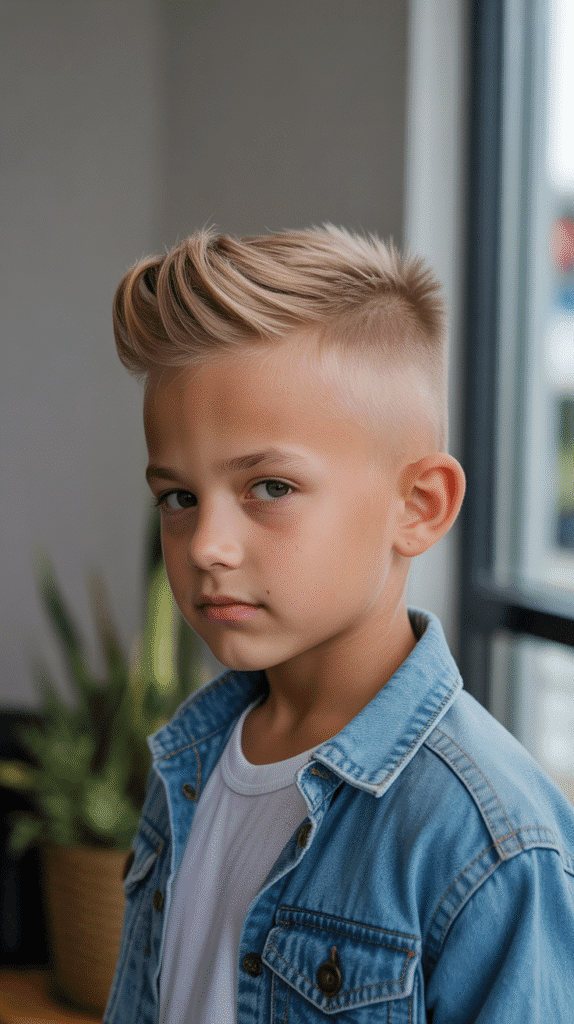
The faux hawk offers an edgy alternative to traditional school haircuts while remaining acceptable in most educational settings.
This style features shorter sides with a strip of longer hair running from the forehead to the back of the head.
- The faux hawk can be worn casually for school with minimal styling or spiked up for weekends and special events.
- This cut appeals to boys who want to express individuality while still meeting school grooming standards.
- Parents can create the look with a small amount of gel or mousse applied to damp hair and directed toward the center.
- The style works best for boys with thick or coarse hair that has natural body.
- It’s particularly popular among elementary and middle school boys who follow current trends.
10. Caesar Cut

The Caesar cut, named after Julius Caesar, features short hair all around with a small fringe combed forward across the forehead.
This Roman-inspired style offers a distinctive look that’s both historical and contemporary.
- The forward fringe helps conceal a larger forehead or irregular hairline, making it a practical choice for boys self-conscious about these features.
- This cut requires minimal to no styling product, as the natural forward growth pattern maintains the look.
- It’s an excellent option for boys with fine or thin hair, as the forward styling creates the appearance of more density.
- The Caesar cut suits boys who prefer a distinctive look without the maintenance of more complex styles.
- It works well for both straight and slightly wavy hair textures.
11. Undercut
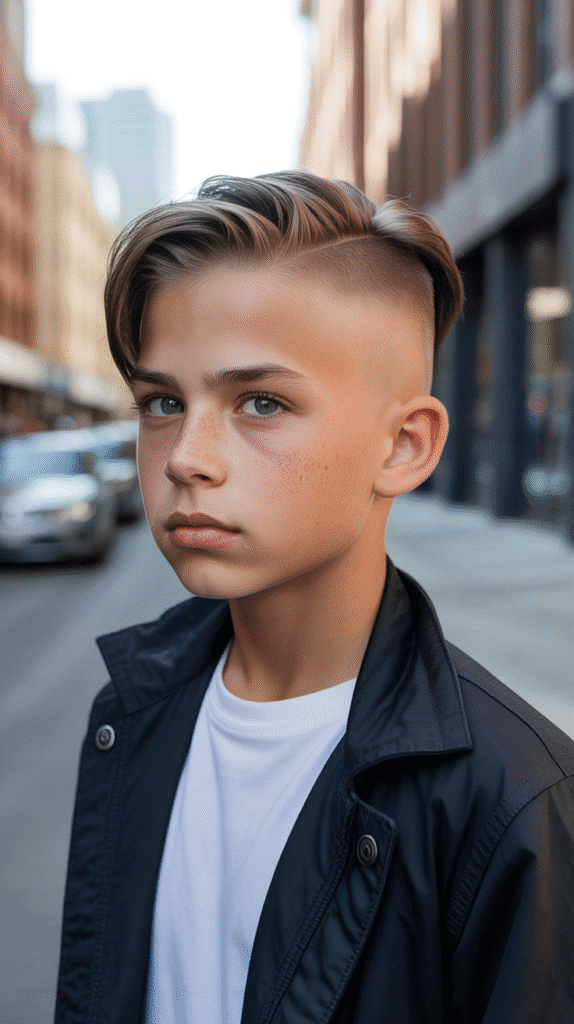
The undercut features a stark contrast between very short or shaved sides and significantly longer hair on top.
This versatile style allows for multiple styling options while keeping the sides ultra-low maintenance.
- The length on top can be styled in various ways: slicked back, pushed forward, swept to the side, or left textured and messy.
- This cut requires regular maintenance on the sides (every 2-3 weeks) to keep the contrast sharp, but the top can grow longer between cuts.
- It’s particularly popular among older elementary and middle school boys who want a fashion-forward look.
- The undercut works well for boys with thick hair, as it removes bulk from the sides while allowing expression through the longer top.
- Parents should check school dress codes, as some conservative institutions may have restrictions on dramatic undercuts.
12. Taper Fade
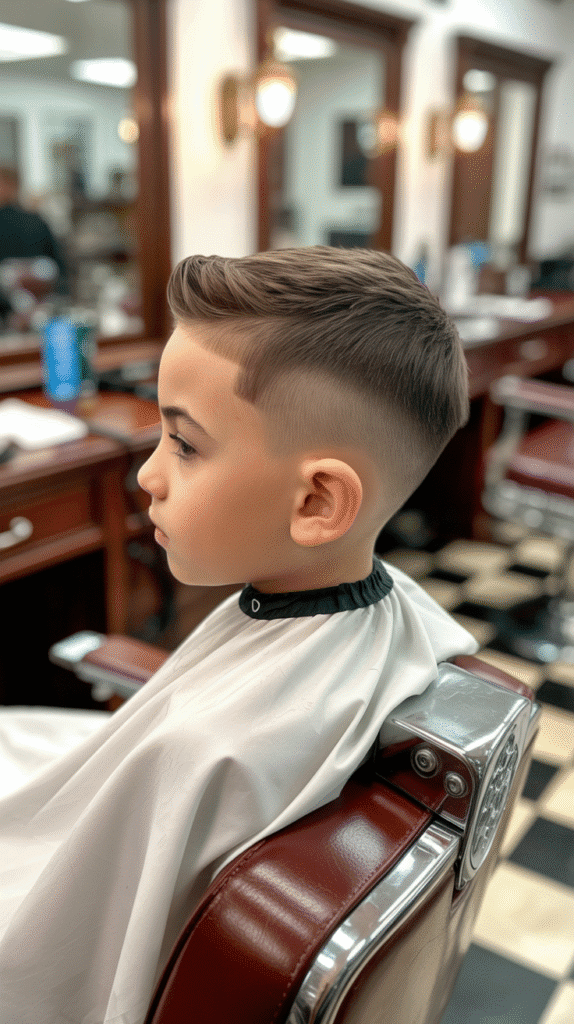
The taper fade gradually transitions from longer hair on top to progressively shorter hair down the sides and back, creating a smooth, blended effect.
This professional-looking cut has become one of the most requested styles in barbershops.
- The gradual fade creates a polished appearance that’s appropriate for all school settings while still being stylish.
- This cut can be customized with different fade heights (low, mid, or high) based on personal preference and school guidelines.
- The taper fade works beautifully with various top styles, from short and textured to longer and swept over.
- It suits all hair types and face shapes, making it a universally flattering option.
- Boys with this cut look well-groomed with minimal effort, as the fade itself provides structure and definition.
13. Spiky Top

The spiky top features short sides with slightly longer hair on top that’s styled upward into small spikes.
This playful style appeals to boys who want a fun, youthful appearance.
- The spiky style requires a small amount of strong-hold gel or wax applied to damp hair and directed upward with fingers.
- This cut is ideal for boys with thick, straight hair that naturally wants to stand up.
- The style maintains its shape throughout the school day once set with product in the morning.
- It’s particularly popular among younger elementary school boys who enjoy the playful, energetic look.
- Parents can adjust the spike height based on school dress codes, keeping them subtle for strict environments or more pronounced for relaxed settings.
14. Bowl Cut (Modern Version)
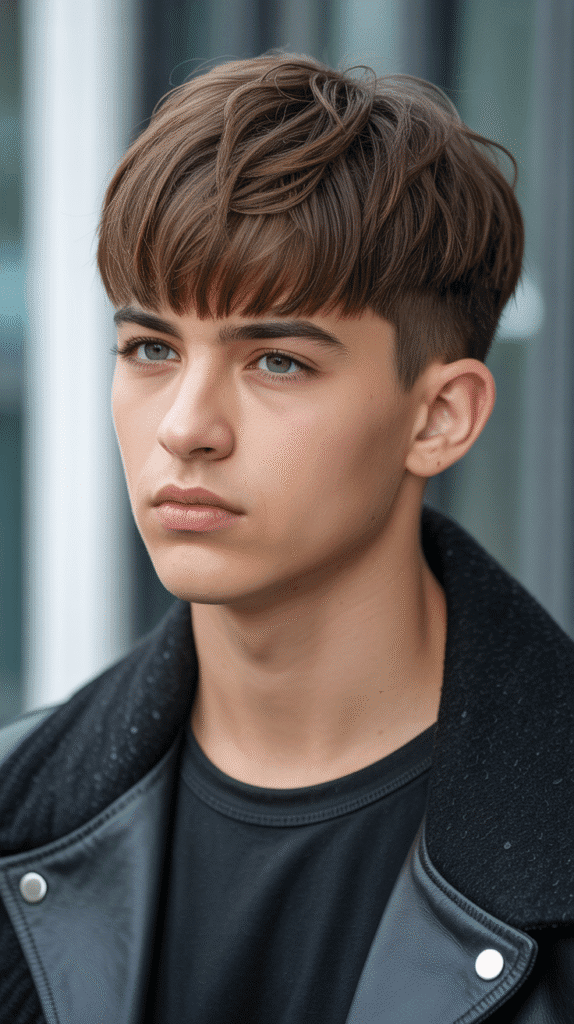
The modern bowl cut bears little resemblance to its dated predecessor, featuring textured layers and a more natural shape.
This updated version provides a retro-inspired look that’s currently trending among fashion-conscious families.
- The contemporary bowl cut includes texture and movement rather than the blunt, one-length cut of decades past.
- This style works well for boys with straight or slightly wavy hair and creates a distinctive, memorable appearance.
- It requires minimal daily styling, as the cut’s shape provides structure naturally.
- The modern bowl cut appeals to artistic or creative families seeking alternatives to mainstream styles.
- Parents should ensure their child is comfortable with this distinctive look, as it stands out among traditional school haircuts.
15. Messy Quiff

The messy quiff combines volume on top with shorter sides, featuring hair styled upward and slightly back in a deliberately tousled manner.
This style offers a perfect balance between looking put-together and effortlessly cool.
- The “messy” aspect means perfection isn’t required, making it ideal for rushed morning routines.
- This cut works best for boys with thick or wavy hair that naturally has body and movement.
- Parents can create the look by applying a small amount of texturizing product to damp hair and directing it upward and back.
- The messy quiff is popular among older elementary and middle school boys who want a mature yet age-appropriate style.
- It transitions well from school to extracurricular activities without looking too formal or too casual.
16. Short Afro

For boys with naturally curly or coily hair, the short afro celebrates their natural texture while keeping hair manageable for school.
This style features evenly trimmed curls that form a rounded shape around the head.
- The short afro requires regular moisture through leave-in conditioners and natural oils to maintain healthy curls.
- This style typically needs trimming every 3-4 weeks to maintain its rounded shape and even length.
- It’s an excellent low-maintenance option that requires no daily styling beyond moisturizing.
- The short afro works well for active boys, as the hair stays in place during sports and play.
- This style celebrates natural hair texture and promotes positive self-image for boys with curly or coily hair.
17. Temple Fade
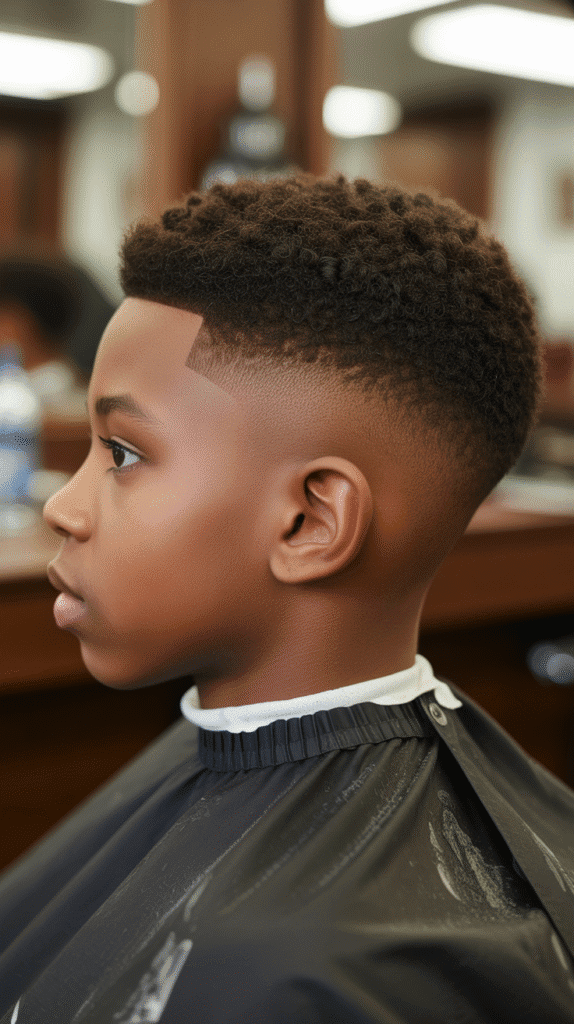
The temple fade focuses on gradually fading the hair specifically around the temples while keeping more length on the sides and back compared to a traditional fade.
This subtle style offers definition without dramatic contrast.
- The temple fade creates a clean, defined look around the face without requiring extreme length differences.
- This style suits boys with all hair types and provides a neat appearance with moderate maintenance requirements.
- It’s an excellent choice for boys transitioning from longer to shorter styles, as it maintains some length overall.
- The temple fade pairs well with various top styles, from slicked back to textured and messy.
- It’s appropriate for all school settings and grows out more gracefully than higher, more dramatic fades.
18. Mohawk Fade
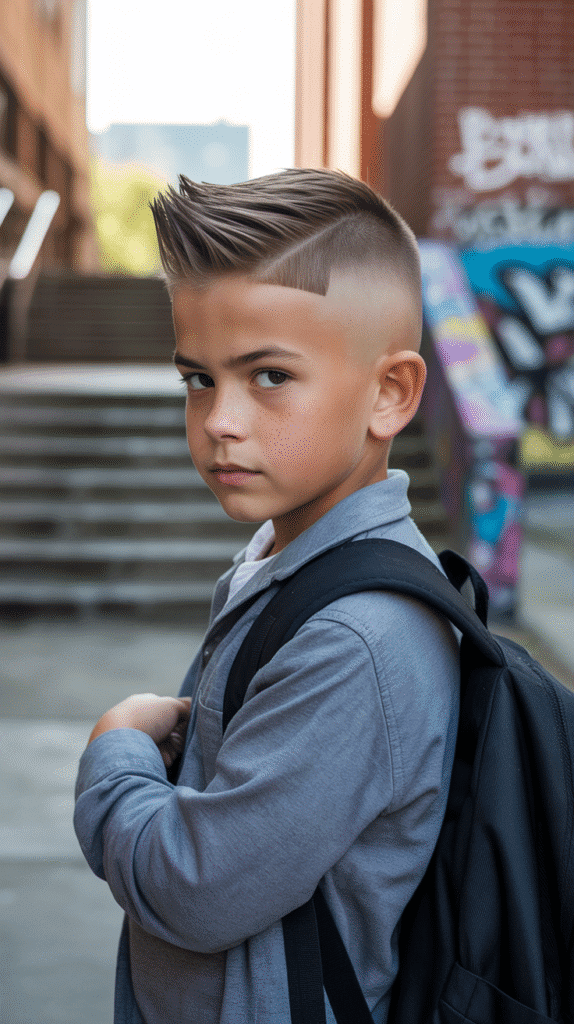
The mohawk fade combines the edgy appeal of a mohawk with the professionalism of a fade, creating a school-appropriate version of this bold style.
The sides fade gradually into the skin while a strip of longer hair runs down the center.
- The faded sides make this version much more acceptable for school than a traditional mohawk with shaved sides.
- Boys can style the center section various ways: spiked up for weekends, brushed forward for school, or left textured and natural.
- This cut requires weekly maintenance on the sides to keep the fade fresh and the mohawk defined.
- It’s popular among boys who want to express individuality while still adhering to school grooming policies.
- The mohawk fade works best with thick, coarse hair that provides enough body to support the center styling.
19. Slicked Back
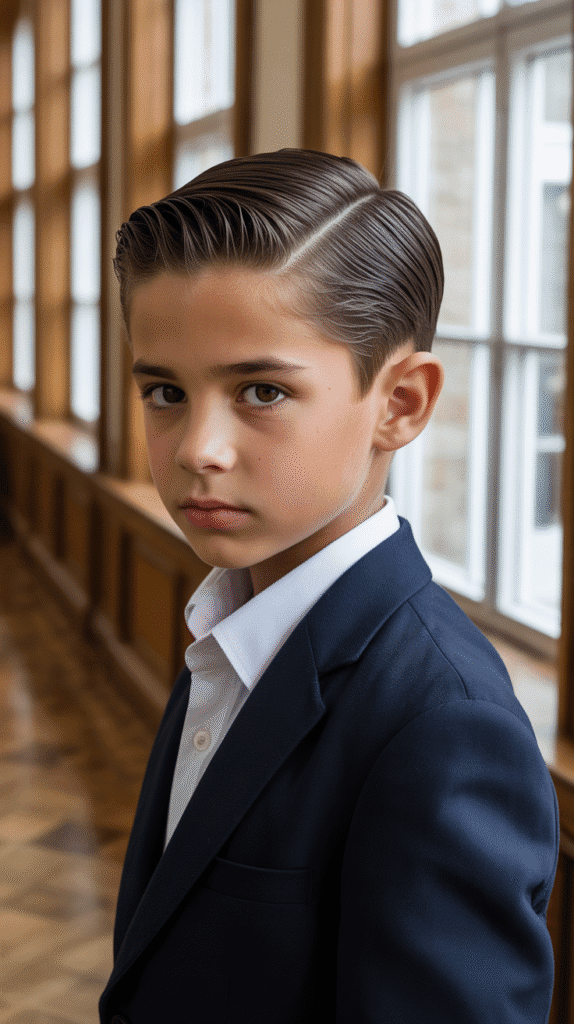
The slicked back style features hair combed straight back from the forehead, creating a sophisticated, mature appearance.
This classic look has been modernized with more natural texture and less rigid product use.
- The modern version uses lighter products than traditional pomades, creating a slicked look that still has movement and doesn’t appear stiff.
- This style works well for boys with straight or slightly wavy hair and requires medium length on top (2-4 inches).
- Parents can achieve the look by applying product to damp hair and combing it straight back, allowing it to set as it dries.
- The slicked back style is ideal for school presentations, performances, and formal events while remaining practical for daily wear.
- It suits older elementary and middle school boys who want a more grown-up appearance.
20. Curly Top with Fade

For boys with naturally curly hair, pairing their curls on top with faded or short sides creates a stylish, manageable look that celebrates their texture.
This combination provides structure while allowing curls to shine.
- The fade removes bulk from the sides while keeping attention on the beautiful curls on top.
- This style requires proper curl care, including sulfate-free shampoo, regular conditioning, and curl-defining products.
- Boys with this cut should refresh curls in the morning with a water spray and curl cream or leave-in conditioner.
- The curly top with fade works for all curl types, from loose waves to tight coils.
- It’s an empowering style that encourages boys to embrace their natural hair texture rather than fighting against it.
21. Pompadour (Youth Version)
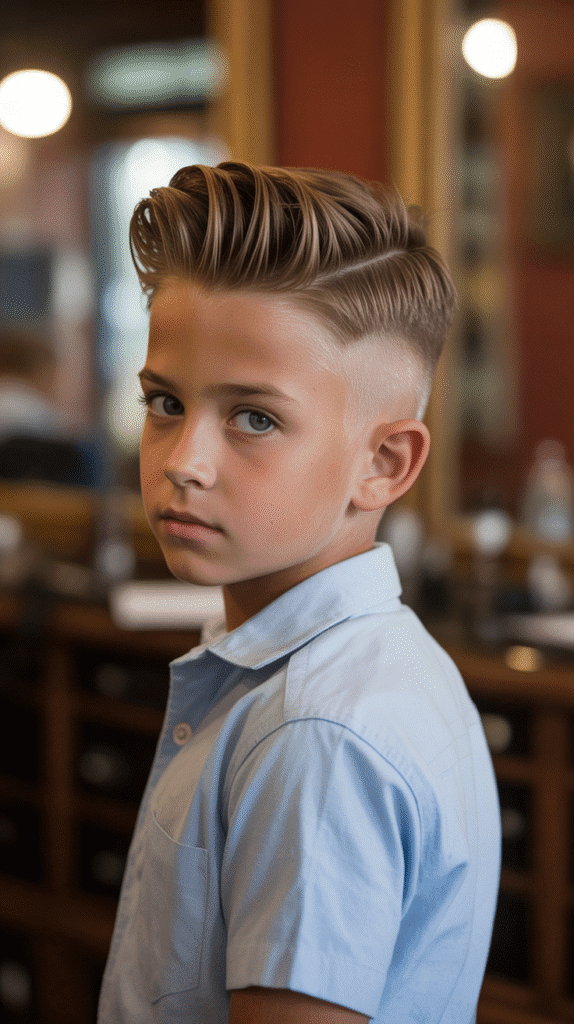
The youth pompadour adapts the classic adult style with less height and drama, featuring volume on top that’s swept upward and back.
This stylish cut provides a retro-modern look that’s appropriate for school.
- The youth version maintains volume without excessive height, making it school-appropriate while still being distinctive.
- This style requires medium-hold pomade or styling cream and 2-3 minutes of morning styling time.
- It works best for boys with thick, straight hair that can support the upward styling.
- The pompadour suits formal occasions beautifully while remaining practical for everyday school wear.
- Boys typically need 3-4 inches of length on top to achieve this look properly.
22. Burst Fade

The burst fade creates a semicircular fade pattern around the ears, “bursting” out from behind them.
This creative take on the traditional fade adds artistic flair to an otherwise standard short cut.
- The burst fade provides visual interest without requiring extreme length differences or unconventional styling.
- This cut pairs well with various top styles, from curly to straight, textured to sleek.
- It’s particularly popular among boys who want something unique that their classmates won’t have.
- The burst fade requires skilled barbering and should be refreshed every 2-3 weeks to maintain its distinctive shape.
- Most schools accept this style as it’s essentially a creative variation on standard short sides.
23. Brushed Forward
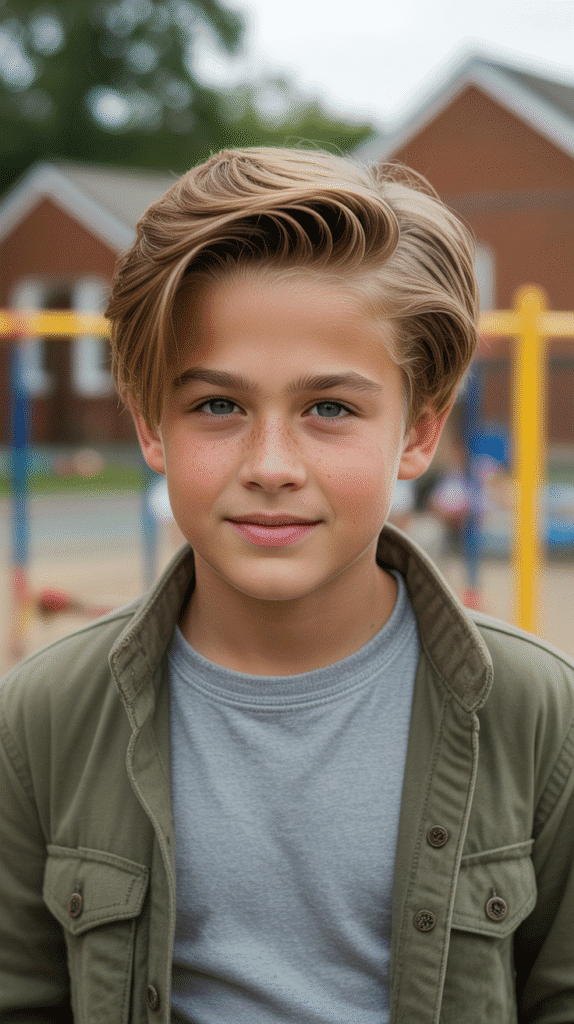
The brushed forward style features hair directed toward the forehead, creating a casual, youthful appearance.
This simple cut works with the hair’s natural forward growth pattern rather than against it.
- This style is ideal for boys who resist spending time on hair, as it requires no product and minimal styling.
- The brushed forward look works particularly well for boys with cowlicks or hair that naturally wants to grow forward.
- It suits all face shapes and hair textures, making it a universally accessible option.
- Boys simply need to comb or brush their hair forward after washing and let it air dry naturally.
- The style maintains a neat appearance throughout the school day without any touch-ups required.
24. Angular Fringe
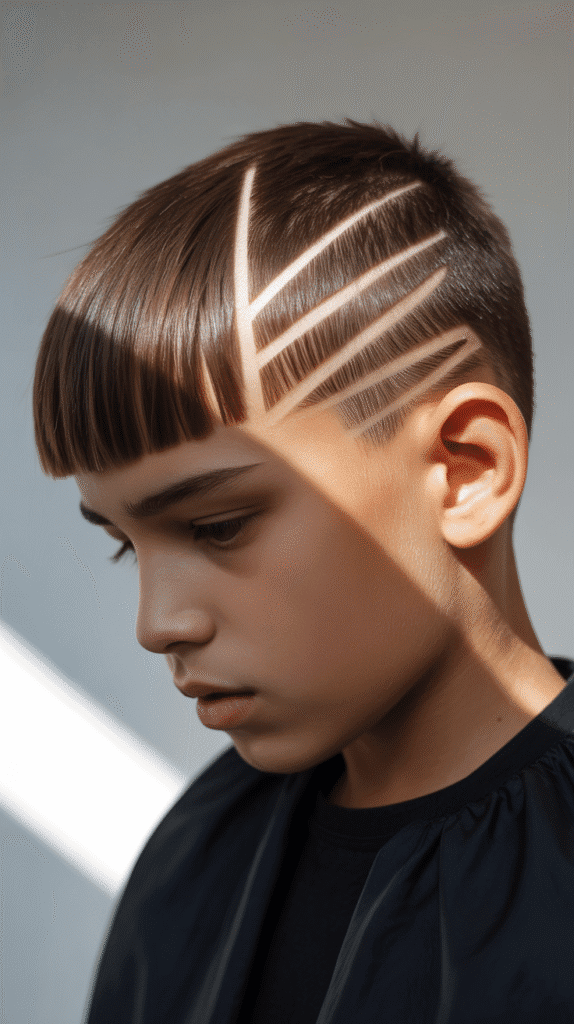
The angular fringe features a diagonal line of hair across the forehead, typically longer on one side and shorter on the other.
This contemporary cut adds geometric interest to a standard short haircut.
- The angular cut creates dimension and visual interest without requiring any daily styling effort.
- This style works well for boys who want something different from the standard straight-across fringe.
- It’s particularly flattering for boys with square or oval face shapes.
- The angular fringe can be subtle for conservative schools or more dramatic for relaxed dress code environments.
- Boys need 2-3 inches of length in front to achieve the proper diagonal effect.
25. Drop Fade
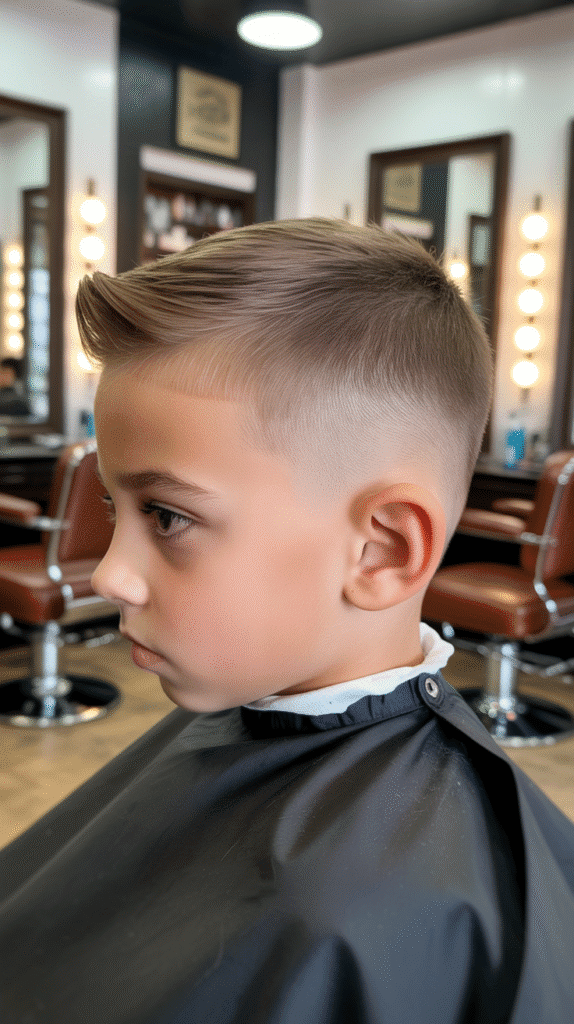
The drop fade curves down behind the ears following the natural head shape rather than creating a straight line.
This technical fade variation adds sophistication to standard short cuts.
- The drop fade creates a more natural, flowing transition than traditional straight fades.
- This style suits boys with all head shapes but is particularly flattering for those with prominent ears, as it draws attention downward.
- It requires skilled barbering and regular maintenance every 2-3 weeks to keep the curve defined.
- The drop fade pairs beautifully with textured tops, curls, or even longer styled hair.
- It’s a subtle way to add sophistication to what appears to be a standard fade at first glance.
26. Textured Fringe
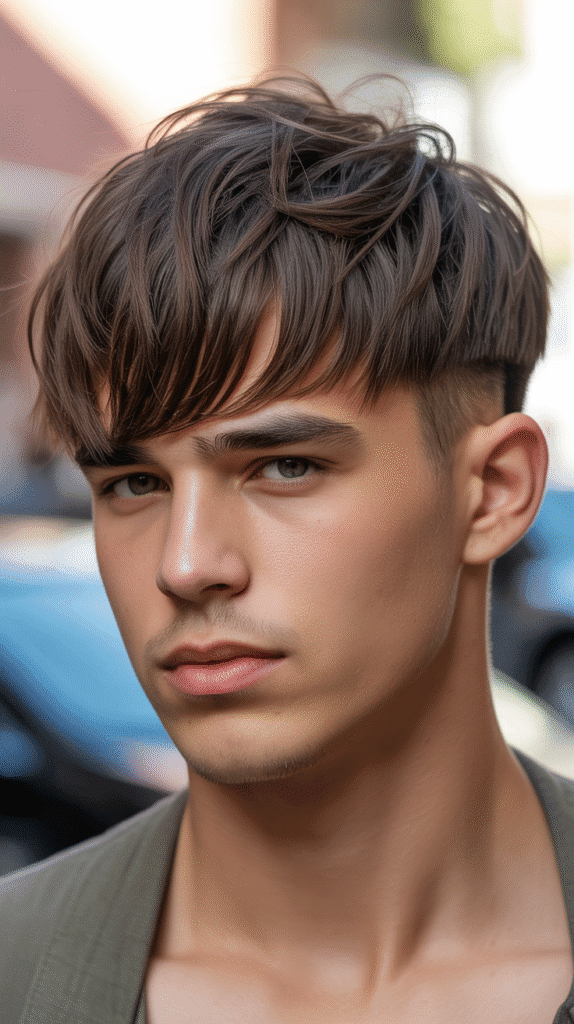
The textured fringe combines a forward-falling fringe with choppy, textured layers on top.
This modern European-inspired style offers movement and dimension while remaining school-appropriate.
- The textured cutting technique means the style looks intentionally messy, eliminating pressure for perfect styling.
- Boys can achieve the look with a small amount of texture paste worked through damp hair with fingers.
- This cut works exceptionally well for thick, straight hair that tends to lie heavy without texture.
- It’s popular among fashion-conscious families seeking alternatives to standard American-style cuts.
- The textured fringe maintains its shape well between haircuts, as the choppy layers grow out gracefully.
27. Short Dreadlocks

For boys with coily or kinky hair, short dreadlocks provide a low-maintenance protective style that’s appropriate for school.
This cultural hairstyle celebrates natural texture while keeping hair neat and managed.
- Short dreadlocks require initial setup time but then need minimal daily maintenance beyond moisture and occasional retwisting.
- This style protects natural hair from damage caused by daily manipulation and styling.
- Boys should maintain locs with loc-specific shampoo and natural oils to keep them healthy and neat.
- The style is appropriate for schools that honor cultural hairstyles and natural hair textures.
- Locs can be styled in various ways with rubber bands or left loose, providing versatility within the protective style.
28. Scissor Cut
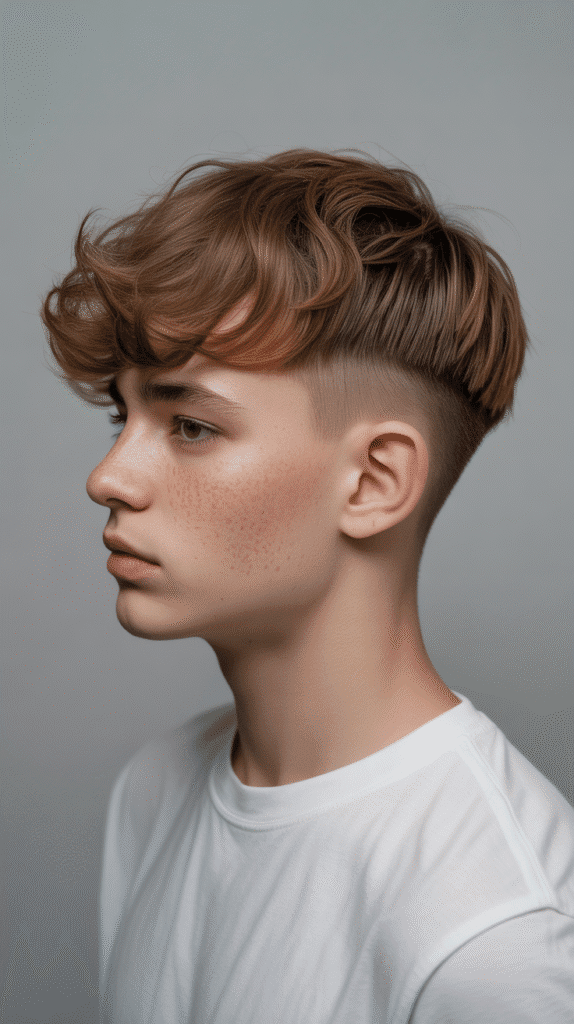
The scissor cut refers to any haircut done entirely with scissors rather than clippers, creating a softer, more natural finish.
This technique works particularly well for boys with wavy or curly hair.
- The scissor-cut approach creates a less severe, more natural appearance than clipper cuts.
- This technique is ideal for boys transitioning from longer to shorter hair, as it maintains softer edges.
- Scissor cuts typically last longer between appointments, as the softer edges blend more naturally as hair grows.
- This method works beautifully with all hair textures but particularly enhances wavy and curly patterns.
- Boys with scissor cuts have a more organic, European-influenced appearance compared to the sharper lines of American barbershop cuts.
29. Long Top with Short Sides
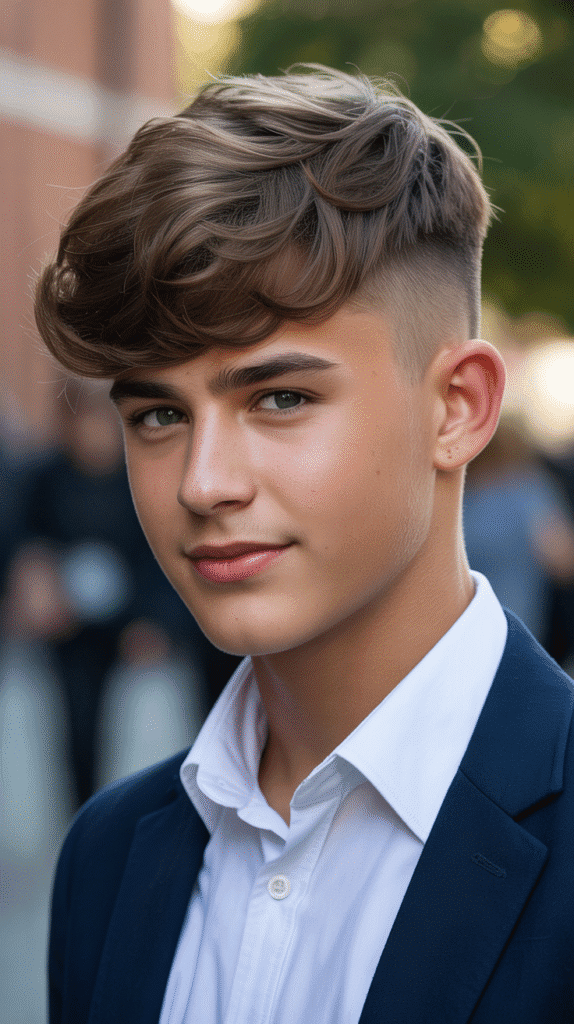
This versatile category includes any cut that maintains significant length on top (3-5 inches) while keeping sides short.
This provides maximum styling flexibility while remaining manageable for school.
- The longer top allows boys to experiment with different styles: slicked back for formal events, swept over for daily wear, or textured and messy for casual days.
- This cut grows out well, maintaining its shape for 6-8 weeks between haircuts.
- Boys need to invest 2-3 minutes in morning styling, but the versatility makes it worthwhile.
- The style suits older elementary and middle school boys who want more control over their appearance.
- It works with all hair types but requires different products: pomade for straight hair, curl cream for curly hair, texture paste for wavy hair.
30. Skin Fade
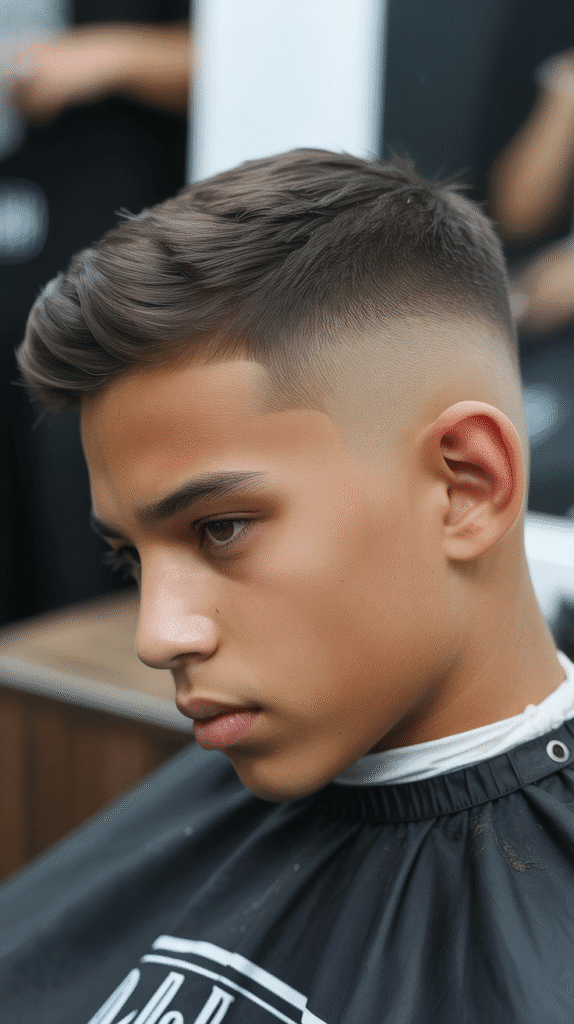
The skin fade takes hair down to the skin at the hairline, creating the most dramatic transition from the top to the sides.
This bold style makes a strong visual statement while remaining appropriate for most schools.
- The skin fade requires the most frequent maintenance of any style on this list, needing touch-ups every 1-2 weeks.
- This dramatic cut creates the sharpest, most defined look possible for boys’ haircuts.
- It works with all hair types and textures on top, from straight to curly, short to long.
- The skin fade is particularly popular among boys who take pride in having the freshest, sharpest cuts at school.
- Parents should budget for regular barber visits to maintain this high-maintenance but impressive style.
31. Regulation Cut
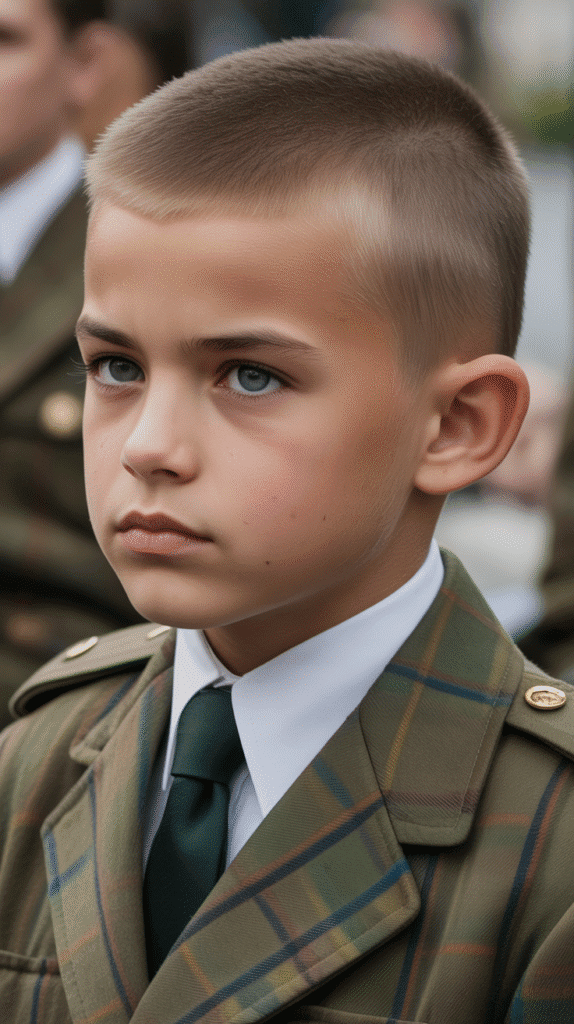
The regulation cut is a conservative, military-inspired style featuring short, even length all around with no distinctive styling.
This ultra-practical cut prioritizes function over fashion.
- The regulation cut is ideal for boys attending schools with strict dress codes or military-affiliated educational institutions.
- This style requires zero morning styling time and minimal maintenance between cuts.
- It’s an excellent choice for boys who genuinely don’t care about their hair and want to minimize time spent on appearance.
- The cut grows out evenly and maintains a neat appearance for 3-4 weeks.
- It suits all face shapes and hair types, being one of the most universally appropriate options available.
32. Mushroom Cut
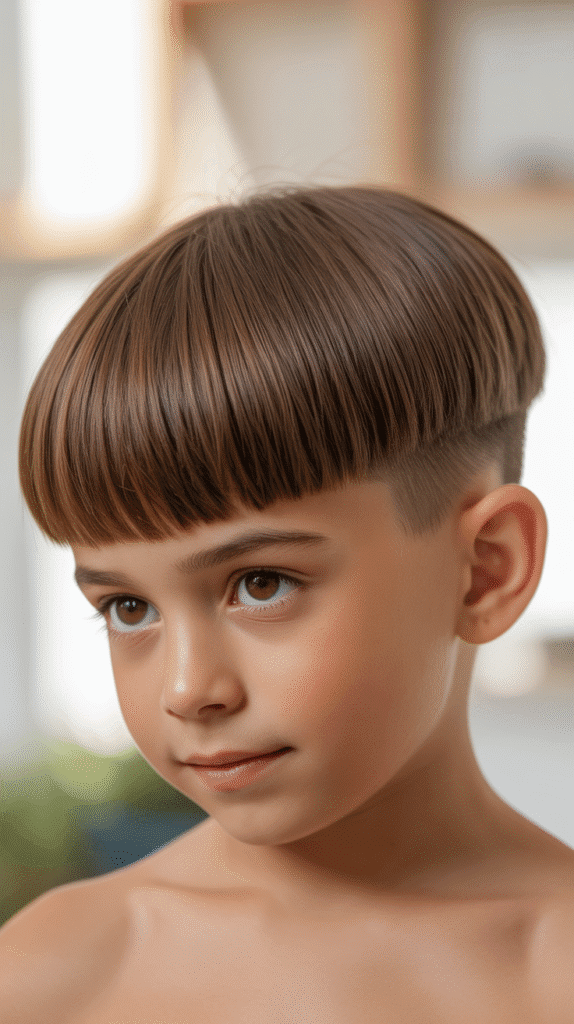
The mushroom cut features rounded, bowl-like shape with more texture and softness than traditional bowl cuts.
This distinctive style has gained popularity for its unique silhouette and easy maintenance.
- The mushroom cut works best for boys with thick, straight hair that can support the rounded shape.
- This style requires minimal daily maintenance, as the cut’s shape provides structure naturally.
- It’s a distinctive choice that helps boys stand out from classmates with more standard cuts.
- The rounded shape can be customized based on face shape, being more elongated for round faces or rounder for longer faces.
- Boys should be comfortable with this non-traditional style, as it attracts attention and comments.
Tips for Choosing the Right School Haircut
Selecting the perfect haircut for your school-aged boy involves considering multiple factors beyond just appearance.
The right choice balances your child’s preferences, your morning routine limitations, and school requirements while working with his natural hair characteristics.
- Consider your child’s activity level and whether he participates in sports that require hair to stay out of his face during competition or practice.
- Review your school’s dress code policy carefully, as some institutions have specific requirements regarding hair length, style, and even restrictions on fades or designs.
- Assess your morning time constraints honestly; if you’re constantly running late, choose a style requiring minimal or no styling time.
- Factor in the frequency of haircut appointments you can realistically maintain, as some styles require weekly touch-ups while others last two months.
- Bring reference photos to the barber or stylist showing multiple angles of the desired cut to ensure clear communication.
- Consider your child’s hair texture and growth patterns, as some styles work against natural characteristics and require constant fighting.
- Involve your son in the decision-making process, especially if he’s old enough to have opinions, as he’ll be more likely to maintain a style he chose himself.
- Start with a conservative version of a style if trying something new, as it’s easier to go shorter or more dramatic on the next visit than to wait for hair to grow back.
Hair Care Products for School-Age Boys
The right products make maintaining school-ready haircuts significantly easier.
Understanding which products serve which purposes helps parents create efficient morning routines and keeps boys’ hair looking its best throughout the school day.
- Light Hold Gel: Creates structure and hold without stiffness or crunchiness; ideal for boys who need their hair to stay in place but look natural (brands like American Crew and Baxter of California offer quality options).
- Texturizing Paste: Provides flexible hold while adding separation and definition to hair; perfect for textured cuts and messy styles that should look intentionally undone.
- Pomade: Offers strong hold with shine (petroleum-based) or flexible hold with natural finish (water-based); best for slicked styles, side parts, and pompadours.
- Leave-In Conditioner: Essential for boys with curly or coily hair; provides moisture, reduces frizz, and makes hair more manageable without weighing it down.
- Sea Salt Spray: Creates natural texture and volume; ideal for wavy hair and beach-inspired looks that need body without stiffness.
- Hair Wax: Delivers the strongest hold for spiky styles or dramatic shapes; should be used sparingly as a little goes a long way.
- Dry Shampoo: Extends time between hair washing, which is particularly useful for busy school mornings when there’s no time for a full wash and dry routine.
- Avoid adult-strength products on young children, as their hair and scalp are more sensitive and don’t require professional-grade formulations.
Communication with Your Barber or Stylist
Establishing effective communication with your child’s barber or stylist ensures consistent, satisfactory results with each visit.
Clear expectations and ongoing dialogue create a partnership that benefits everyone involved.
- Schedule regular appointments on the same day and time (like every third Saturday at 10 AM) to maintain consistency and ensure availability.
- Bring reference photos showing front, side, and back views of the desired style, as visual references prevent misunderstandings about length and technique.
- Use specific terminology rather than vague descriptions: say “number 2 guard on sides” instead of “short on sides,” or “2 inches on top” rather than “not too short.”
- Discuss growth patterns and problem areas during the first appointment so the stylist can account for cowlicks, whorls, or unusual hairlines in their cutting plan.
- Ask the barber to show your son how to style his hair at home, demonstrating product application and any necessary combing or brushing techniques.
- Request a slightly longer cut if you’re unsure about a new style, as you can always go shorter at the next appointment but can’t add length back.
- Establish realistic expectations about maintenance requirements, asking directly how often the cut will need refreshing and how much daily styling is required.
- Build rapport with one consistent stylist rather than switching between multiple professionals, as familiarity with your child’s hair leads to better results over time.
- Provide feedback after each cut, mentioning what worked well and what could be adjusted next time to continuously improve the results.
- Ask about seasonal adjustments, as hair that works well in winter may be too warm for summer, and vice versa.
Managing Different Hair Textures
Understanding your son’s specific hair texture helps you choose appropriate styles and maintain them effectively.
Different textures require different approaches to cutting, styling, and daily care.
Straight Hair
- Straight hair shows every imperfection in a cut, so precision is essential when selecting a barber or stylist for geometric styles.
- This texture works beautifully with slicked styles, side parts, and clean-lined cuts that emphasize the hair’s natural smoothness.
- Boys with straight hair often need less product than those with other textures, as the hair naturally lies flat and stays in place.
- The challenge with straight hair is adding volume and texture when desired, which requires texturizing cuts and appropriate styling products.
Wavy Hair
- Wavy hair offers the best of both worlds, having enough texture for interest but not so much curl that it becomes difficult to manage.
- This texture works well with most cuts on this list and can be styled straight or worn naturally wavy depending on the occasion.
- Boys with wavy hair benefit from leave-in conditioners that enhance waves without creating frizz.
- The natural body of wavy hair means cuts maintain their shape well and often look better after a few days than immediately after cutting.
Curly Hair
- Curly hair should typically be cut dry by a stylist experienced with curls, as cutting wet curly hair can lead to unexpected results when it dries.
- This texture benefits from styles that work with the curls rather than against them, such as curly top fades or short afros.
- Moisture is essential for healthy curls, requiring sulfate-free shampoos, regular conditioning, and curl-defining products.
- Boys with curly hair should avoid brushing dry curls, which creates frizz; instead, detangle in the shower with conditioner using fingers or a wide-tooth comb.
Coily/Kinky Hair
- Coily hair is the most fragile texture and requires gentle handling, protective styles, and consistent moisture to prevent breakage.
- This texture works beautifully with short afros, dreadlocks, twists, and faded styles that keep the sides short while celebrating the natural texture on top.
- Regular deep conditioning treatments help maintain hair health and make daily styling easier.
- Boys with coily hair benefit from satin or silk pillowcases that reduce friction during sleep and help maintain hairstyles overnight.
School Dress Code Considerations
Navigating school dress codes requires understanding both written policies and unwritten cultural expectations.
Being proactive about hair guidelines prevents conflicts and ensures your son’s haircut remains appropriate throughout the school year.
- Request a copy of the student handbook or dress code policy before selecting a haircut, paying special attention to any hair-specific regulations.
- Conservative schools often have restrictions on hair length (typically above the collar, ears, and eyebrows), unnatural colors, and extreme styles.
- Some institutions specifically prohibit shaved designs, patterns, or lines in hair, while others allow these elements as long as they’re not offensive.
- Private schools, religious schools, and military academies typically have stricter requirements than public schools, often requiring traditional, conservative cuts.
- When in doubt, choose a classic style like a crew cut, side part, or taper fade, as these universally acceptable options never violate dress codes.
- If your son wants a trendier cut, email the school administrator with a photo of the proposed style before getting the haircut to confirm it meets guidelines.
- Understand that dress code enforcement can vary by administrator, so what was acceptable last year might be questioned by a new principal or dean.
- Teach your son that hair, while important for self-expression, shouldn’t become a source of ongoing conflict with school authorities that disrupts his education.
Budget-Friendly Haircut Options
Maintaining regular haircuts for school-aged boys can strain family budgets, especially with styles requiring frequent trims.
Several strategies help manage costs without sacrificing quality.
- Research barber schools and cosmetology schools in your area, which offer supervised student cuts at significantly reduced prices (often $5-10 instead of $20-40).
- Invest in quality clippers (around $50-100) and learn to do basic maintenance trims at home between professional cuts, extending the time between paid appointments.
- Look for barbershops offering children’s rates, weekday specials, or package deals where buying multiple cuts in advance reduces the per-cut cost.
- Choose styles that grow out gracefully and don’t require frequent maintenance, such as crew cuts, textured crops, or scissor cuts rather than skin fades.
- Ask if your barber offers a punch card system or loyalty program rewarding regular customers with free cuts after a certain number of visits.
- Consider doing simple styles at home entirely, such as buzz cuts or basic trim work, reserving professional cuts for special occasions or the start of school.
- Share stylist recommendations with other parents to find affordable, quality options, as word-of-mouth referrals often lead to the best value providers.
- Time haircuts strategically, getting cuts right before school starts and at holiday breaks when fresh appearances matter most, allowing slightly longer growth periods between cuts.
Seasonal Haircut Adjustments
Your son’s ideal haircut may change with the seasons based on temperature, humidity, activities, and practical considerations.
Adapting his style throughout the year maintains comfort and manageability.
Fall/Back-to-School
- Choose a fresh, clean style that makes a good first impression for new teachers and classmates.
- Moderate length works well as temperatures transition, being cool enough for warm early fall days but providing some coverage as weather cools.
- Consider slightly more polished styles for school photos, which typically occur in September or October.
- This is an ideal time to try a new style, as the fresh start of school provides a natural transition point.
Winter
- Slightly longer styles provide warmth and protection from cold temperatures, wind, and dry indoor heating.
- Boys who play winter sports may prefer shorter cuts that fit easily under helmets and don’t create discomfort with hats.
- Static electricity affects hair more in winter, so using leave-in conditioner or anti-static products helps maintain neat appearance.
- Less frequent washing during winter helps preserve natural oils that protect hair from harsh weather conditions.
Spring
- Transitional styles work well as weather warms, often slightly shorter than winter cuts but not as dramatically short as summer styles.
- Spring is an excellent time to start growing hair out if planning a different summer look or to cut shorter in preparation for warm weather.
- Increased outdoor activities mean boys may prefer styles that stay neat despite wind, rain, and more active play.
- Allergy season might make longer fringes uncomfortable for boys who frequently rub their eyes or face.
Summer
- Many families opt for the shortest cuts of the year during summer, choosing buzz cuts, crew cuts, or other minimal-maintenance styles.
- Boys attending summer camp benefit from ultra-short cuts that require no products, minimal washing, and no styling time.
- Swimming pool chlorine and ocean salt water can damage hair, so shorter styles minimize this exposure and associated maintenance.
- Hot, humid weather makes longer styles uncomfortable, and shorter cuts keep boys cooler during outdoor activities.
Dealing with Cowlicks and Growth Patterns
Cowlicks and unusual growth patterns challenge even experienced stylists, but understanding how to work with rather than against them creates more manageable haircuts.
- Cowlicks are sections of hair that grow in different directions from surrounding hair, creating areas that stick up or refuse to lie flat.
- The most common cowlick locations are the crown (back of head), hairline, and occasionally at the sides near the temples.
- Very short cuts (buzz cuts, crew cuts) eliminate cowlick visibility by cutting below the length where the directional growth becomes apparent.
- Stylists can cut hair slightly longer in cowlick areas, using the extra weight to help hair lie flatter against the head.
- Working with the cowlick’s natural direction rather than against it creates more natural-looking, manageable styles that don’t require constant fighting.
- Products with strong hold help control cowlicks in longer styles, though they’ll never completely eliminate the directional growth.
- Some cowlicks actually enhance certain styles—a forward cowlick at the hairline creates natural volume for quiffs and pompadours.
- If a particular style never works despite multiple attempts, the issue may be incompatibility with your son’s growth patterns rather than poor cutting or styling technique.
Building Your Son’s Hair Care Routine
Establishing consistent hair care habits during the school years creates lifelong grooming skills and self-care practices.
Age-appropriate routines build independence while maintaining hair health.
Elementary School Age (5-10 years)
- Parents should handle most hair care at this age, including washing, product application, and styling.
- Teach basic skills like proper rinsing, gentle towel drying, and simple combing or brushing techniques.
- Use mild, tear-free shampoos and conditioners formulated for children’s sensitive scalps.
- Keep routines simple with minimal steps, focusing on cleanliness and basic neatness rather than complex styling.
Middle School Age (11-13 years)
- Transition responsibility to your son, supervising initial attempts but allowing him to handle daily care independently.
- Teach proper product application techniques, emphasizing that more product isn’t better and demonstrating the small amounts actually needed.
- Discuss hair washing frequency based on hair type and activity level (daily for very oily or active boys, every other day for most, less frequently for very dry or curly hair).
- Allow experimentation with different styles and products within school dress code guidelines, supporting self-expression and identity development.
Practical Skills to Teach
- How to properly wash hair, including massaging shampoo into the scalp rather than just the hair and thoroughly rinsing all product.
- The difference between shampoo (for cleaning) and conditioner (for moisturizing), and why both matter for hair health.
- Appropriate product amounts (usually pea-sized to dime-sized portions for most children’s hair lengths).
- How to work product through hair evenly using fingers or a comb, ensuring full coverage without clumping.
- Basic tool use including combs, brushes, and blow dryers if styling requires them.
- When to seek help—recognizing that some cuts or styles require parental assistance or professional intervention.
Common Haircut Mistakes to Avoid
Learning from others’ experiences helps parents and boys avoid common pitfalls when selecting and maintaining school haircuts.
Awareness of these frequent mistakes saves time, money, and frustration.
- Choosing styles based solely on trends or what looks good on other children without considering your son’s specific hair type, face shape, and daily routine.
- Selecting high-maintenance cuts for boys (or parents) who lack the time, interest, or skill to maintain them properly.
- Cutting hair too short too quickly when trying a new style, leaving no room for adjustment if the result isn’t what was expected.
- Using adult-strength styling products on young children, which can cause scalp irritation, product buildup, or hair damage.
- Failing to communicate clearly with barbers about expectations, leading to repeated dissatisfaction with cuts.
- Forcing styles on reluctant children who hate the way they look, creating negative associations with grooming and self-care.
- Neglecting to factor in growth rate and maintenance requirements when selecting styles, resulting in cuts that look good for only a few days.
- Skipping regular trims to save money, which often leads to needing more dramatic cuts to correct overgrown shapes.
- Washing hair too frequently with harsh shampoos, stripping natural oils and causing dryness, irritation, or damage.
- Comparing your son’s hair to siblings’, friends’, or idealized images without accepting his unique characteristics and working with what he has.
Supporting Your Child’s Confidence
Hair significantly impacts how children feel about themselves, and the right cut can boost confidence while a poor one can create self-consciousness.
Supporting your son through haircut decisions and changes helps build positive self-image.
- Involve your son in haircut decisions at age-appropriate levels, offering limited choices for younger children and greater autonomy as they mature.
- Respond positively to new haircuts even if they’re not exactly what you envisioned, focusing on finding at least one element to genuinely compliment.
- Never criticize your son’s appearance or hair in front of others, which creates embarrassment and damages self-esteem.
- If a haircut goes poorly, acknowledge the disappointment while emphasizing that hair grows back and this is temporary.
- Help younger boys understand that adjusting to a new cut takes a few days, and what feels strange initially often becomes comfortable quickly.
- Teach that personal grooming and neat appearance demonstrate self-respect and consideration for others, not vanity or superficiality.
- Recognize that hair becomes increasingly important to identity during pre-teen and teen years, respecting this developmental stage.
- Address teasing or negative comments from peers by reinforcing that everyone has different preferences and his appearance choices are valid.
- Celebrate positive changes and compliments your son receives about his hair, reinforcing that taking care of his appearance yields positive social responses.
- Model healthy grooming attitudes yourself, as children learn self-care values from observing parents’ behaviors and attitudes.
Conclusion
Finding the perfect school-ready haircut transforms morning chaos into smooth routines while helping your son feel confident and comfortable throughout his school day.
The comprehensive guide to “Effortless Mornings: Top 32 School-Ready Boys’ Haircuts You’ll Love” has explored diverse options from timeless classics like crew cuts and side parts to contemporary styles such as textured crops and faded designs, ensuring every family can find the ideal match for their needs.
The key to success lies in balancing your son’s preferences with practical considerations including hair type, face shape, maintenance requirements, and school dress codes while remembering that the best haircut is one that makes your child feel good about himself.
Whether you choose ultra-low-maintenance buzz cuts that require zero morning time or slightly longer styles that allow for creative expression, the right haircut serves as an investment in your child’s confidence, daily routine efficiency, and overall school experience.
By involving your son in the decision-making process, communicating effectively with skilled barbers or stylists, establishing age-appropriate hair care routines, and providing encouragement through the occasional bad cut or adjustment period, you’re not just managing hair—you’re teaching valuable lessons about self-care, personal presentation, and the confidence that comes from looking and feeling your best.
As you explore these 32 excellent options and implement the practical advice throughout this guide, remember that hair grows, styles change, and what matters most is supporting your son’s journey toward independence while making those precious morning moments together a little bit easier and a lot more pleasant.
